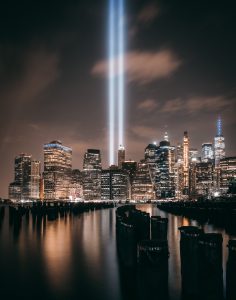
Twenty years ago today, I was an investigative reporter for the New York Post, living in Brooklyn and going through a typical Tuesday morning: getting up at 6am to quietly practice the saxophone, waking my son and preparing him for school before heading to work. I wrote for the Sunday newspaper and had a few projects in the works. But this morning would change everything. It started with a call from a relative who worked for the NYPD.
“Turn on your tv,” my sister said. I did. The first plane had already hit the North Tower. “What do you think,” she asked. After all, I covered terrorism for a living.
“I don’t know yet. It could still be an accident,” I said. Then I saw the second plane hit Tower Two on live television. “It’s terrorism,” I said and put the phone down.
I walked to the school to grab my son but couldn’t get past eh front door. Other parents crowded the security desk. Several mothers wore hijabs and looked especially nervous. Black smoke and debris, including paper documents, were wafting high overhead from downtown Manhattan and across Kensington, Brooklyn. The air no longer seemed safe to breathe on this crisp, sunny day. I left my son in school and returned home.
With no cell phone service, I was able to get through to The Post via landline. We decided I’d work from home and I began calling up sources. At some point, an agent from the Defense Intelligence Agency (DIA) called the paper asking for me. Someone made the unusual call of just giving him my home phone number.
The DIA agent asked me about a June story I wrote about the feds releasing Middle Eastern men who were detained after taking photos of security fixtures in downtown Manhattan. My sources in the Federal Protective Service (FPS) were livid agents from Immigration and Naturalization Service (INS) and later the FBI released the men before the photos were developed. When the proof came back the federal government went into a panic. The men had clearly surveilled federal buildings posing as tourists – right after four al Qaeda members were convicted in Manhattan Federal Court for bombing U.S. embassies in Africa. The story ran on July 1st under the headline “Feds Let Terror Spy Wriggle Free.”
“The incident, which is being kept hush-hush outside federal investigative circles, has law-enforcement officials on edge for fear that real steps toward a terror attack are underway,” the story read. “Internal memos have been circulated about the incident and service officers in other states and in Washington, D.C., have been told about it at roll calls,” the story read.
“The threat level is through the roof,” one source said.
I had no additional information for the DIA agent but he provided his phone number and asked me to update him if anything emerged. Something quickly did. A New York State investigator volunteering in the WTC search and recovery saw my story attached to a U.S. Marshals memo. The Marshals were searching for the suspects, now considered part of Osama Bin Laden’s network. He snatched the memo and called the newspaper.
I met the state investigator at 2am at a Staten Island diner. After some small talk and ordering coffee, he explained how the story caught his eye while he was in a downtown building being used by rescue volunteers to clean up.
“When I read your story I knew this was important,” he said. “So I took it.”
I was stunned when he pushed the documents across the table. The Marshals had photographs of the men the feds set free and more details about the June snafu. I returned home about 4am and told my wife what occurred. Later that morning I called the Post to report my findings. The resulting story highlighted the breakdown between the FPS, INS and the FBI. Shortly before it was published, I called the DIA agent.
“You’re an American hero,” he said before our talk ended.
The story appeared that Sunday, September 16th in a two page spread under the headline: “Feds Released Three Plotters in June.”
“These three subjects were discovered taking pictures in and around an N.Y.C federal facility that served no legitimate purpose,” the memo stated. “Further investigation by the FBI showed that the three have left their last known residences, leaving behind paychecks from their employment.”
The snafu and my stories became part of Congressional hearings, used to highlight the ineffectiveness of domestic law enforcement to protect us from terrorist attacks. At the time, federal law enforcement agencies rarely shared intelligence with one another, not to mention stonewalling local law enforcement. Turf battles were routine. Investigative leads lost. Now the breakdown in communication and cooperation had squandered an opportunity to gather important intelligence just three months ahead of the worst terrorist attack on American soil.
In the tumultuous days following the 9/11 attacks, these stories buttressed arguments in favor of letting the military take the lead in the fight against terrorism. They also exposed the need for a new agency, which would be called the Department of Homeland Security, to ensure timely communication and cooperation among federal and local law enforcement agencies to better prevent future atrocities in America.


